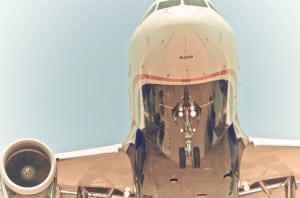Latest News
[Via Satellite 12-16-2014] Gogo does not see Air-to-Ground as sufficient as a standalone solution for in-flight connectivity, according to President and CEO Michael Small.
“I would say that an air-to-ground solution by itself is no longer competitive,” said Small during a UBS investor presentation. “If connectivity is transformative to aviation, you can’t have it some of the time, you have to have it all the time. A high percentage of the planes will be satellite and I would say it is almost too late to get into the business strictly with an ATG network.”
Gogo owns a large ATG network across the United States, and has been fitting aircraft with an enhancement called ATG-4 to improve capacity. Still, the global nature of aviation has widened the coverage area demanded to the point that regional or national coverage alone is insufficient, according to Small.
ATG-4 provides about 10 Mbps to planes compared to 3 Mbps with existing ATG technology. Small said going forward, Gogo’s focus will increasingly center on 2Ku, which uses two low-profile, high efficiency Ku-band satellite antennas from Thinkom to deliver broadband to aircraft at speeds of 70 Mbps or higher. He expects service speeds to climb up to 100 Mbps over time.
“We are actively working on 2Ku and that will really start getting certified in 2015 and really deployed in 2016 and 2017. So you will see a bunch more ATG-4 in 2015 measured in hundreds, and then most of the emphasis after that will be on 2Ku,” said Small.
Gogo’s comments on ATG stand out against a background of increasing ATG activity. This year Inmarsat, AT&T and SmartSky all announced intentions to build ATG networks for IFC. While AT&T later countermanded these plans, Inmarsat and SmartSky have both moved forward with partnerships for networks in Europe and the continental United States, respectively. SmartSky partnered with Textron Aviation, Duncan Aviation, Satcom Direct, ICG, and Harris Corporation for an ATG network launch in 2015. Likewise Inmarsat teamed up with Alcatel-Lucent for an EU-wide network.
“What is interesting to us is the contrast between Inmarsat’s view of ATG and Gogo’s view of ATG,” Andrew Spinola, senior analyst at Wells Fargo wrote in a research note. “Inmarsat is well positioned in the market whether aviation broadband goes to satellite or ATG, in our opinion, but the ATG investment is discretionary and it’s notable that in both its press release announcing the ATG network and its analyst day presentation, Inmarsat highlighted the success of Gogo as supporting evidence for its investment.”
Gogo believes leveraging satellite will provide an additional advantage in pursuing international business. According to the company’s presentation, only 600 aircraft remain unspoken for in North American commercial aviation, with 2,500 planes awarded to Gogo and 1,300 awarded to competitors. Of an estimated 13,300 international aircraft, Gogo has won 300, competitors have won 2,500 and 10,500 remain as of yet uncommitted.
Gogo also sees the barrier to entry into the IFC business as very high.
“No telecommunication provider is just wandering into this business; it’s a massive investment, and you need to get the end-to-end package. You can’t just buy a transponder and say you’re in business. You need to have the customer-facing software, the backroom-facing software, the network facing software, the ability to design and build boxes, get them installed on planes — it’s endless to deliver it all,” said Small.
Internationally, Gogo expects to compete aggressively because it will be starting more customers with the higher speeds of 2Ku, Smalls added. Most recently, Gogo won 250 North American regional aircraft from American Airlines, for which Gogo already connects close to 850 of its aircraft. In the future, Small said he anticipates the Average Revenue Per Aircraft (ARPA) reaching $1 million per plane. This increase in revenue, up from $115 million ARPA as of third quarter 2014, would come from passenger connectivity, passenger entertainment and other connected aircraft features such as cabin connectivity. Through ATG-4 and 2Ku, Gogo expects to see greater revenues as a result of relaxed capacity constraints.
“This will be a boring business with low bandwidth. It will be exciting if we get to 100 Mbps and beyond,” said Small.
Get the latest Via Satellite news!
Subscribe Now